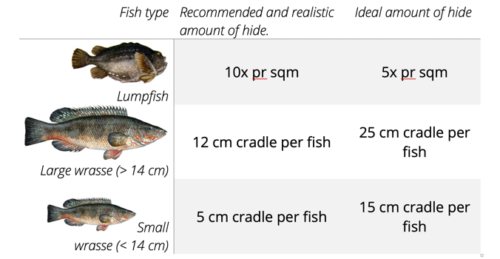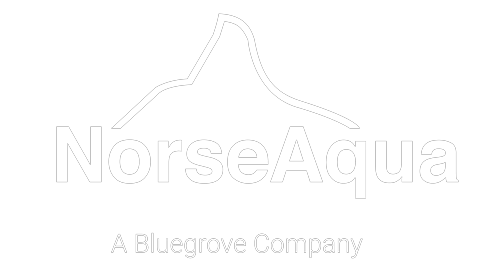Introduction
One of the most important specifications for a cleaning fish hide is how many cleaning fish that can effectively use it. This article shows NorseAqua’s recommendations based on a specific amount and type of cleaning fish. We give examples from normal salmon pens and show recommended products and common tailored solutions.
From Meters to Surface Area and Cradlemeters
Earlier recommendations in the industry have been based on the number of cleaning fish per meter of kelp hide strings. But the width of the string varies, and so does the folds and cuts. All cleaning fish look for shadow and a place to hide from the salmon, but lumpfish uses hides in a different way than wrasse. Different cleaning fish have different needs in their hide.
There are many species used as cleaning fish, but the salmon industry is now primarily using lumpfish (Cyclopterus lumpus) and ballan wrasse. (Labrus bergylta). Our recommendations are therefore based on the needs of these two species. In short, our recommendation is to look at the total surface area when you are calculating the needs for lumpfish, and that you look at the number of meters of cradle space for ballan wrasse.
Lumpfish
The lumpfish has a small build, tall body shape and sharp spikes that can inflict damage on other fish if they are too close to each other. Hides with too small pockets therefore risk causing injuries on lumpfish.
How much area is available for the lumpfish to suck on to? Surface area is calculated from a flat tarp, and both sides are included.

The material used in the hide will also influence the welfare of the cleaning fish. In this area we have done research and can scientifically prove that compared to other materials, our HDPVC have properties that makes it easier for the lumpfish to attach to the hide. In our article on hide materials you can read more about why HDPVC is more suited for lumpfish.
Ballan Wrasse
While the lumpfish needs to attach to the hide to rest, the ballan wrasse needs to lie down and hide in cradles. The size of the cradle should therefore be based on the size of an average ballan wrasse, i.e. approximately 20 cm.
How many meters of cradle is available for the ballan wrasse? The length of the cradles are measured between the cut banners and is given in meters.

Ballan wrasse also needs a guidance string. This is a string that goes deep into the fish cage and guides the wrasse back up to the hide. Without this guidance string, the wrasse may get lost in the depth of the fish cage and not find its way back.
Customized Hides
Cleaning fish hides from NorseAqua can be customized to become ideal for lumpfish, ballan wrasse or both species. Our standard hides can be used on both species simultaneously.
Recommendations
Our recommendations is based a combination of calculating how much space a cleaning fish needs, and experience from using these hides. Maintaining the hides needs to be considered.

Enough hides is important to reduce stress and ensure good health. Tailbiting and aggression can be a challenge if there is not enough hides. Planning not only enough hides, but also use of feeding stations like our belt feeder near hides will reduce this.
It doesn’t matter how many hides you have if you do not maintain it. Good maintenance procedures is therefore essential.
Ideal amount of hides means that all fish at all times have space in the hide. In reality, there will always been some individual fish that are swimming around. Lumpfish live for the first parts of their life in the kelp forests, but turn increasingly into free swimming fish as they grow older.
Examples
Example A: Site with 100% Lumpfish
Number of salmon: 90 000
Percentage of cleaning fish: 7% (6300 lumpfish)
Need for hides: 630-1260 m2 with smooth surface
Solution: 2 x NorseAqua A-00305 Crane Kelp
Calculation: One NorseAqua A-00305 crane kelp gives 480m2 surface area. Two crane kelps of this type placed together in a cleaning lane will then give 960 m2, which should be sufficient for this site.
Comment: If you wish to go up to the ideal amount of hides, you can attach some extra string on the crane kelp to get closer to 1260 m2.
We chose a hide in HDPVC since studies show that lumpfish prefer this material over thinner materials. If the site location is in an area with strong currents, more hides may be necessary. Each site knows their requirements the most.
We chose crane kelp instead of curtain kelp as a crane makes it easier to work with heavy materials like HDPVC, both for installation and drying.
Example B: Site with 100% Ballan Wrasse
Number of salmon: 60 000
Percentage of cleaning fish: 1% (600 ballan wrasse)
Need for hides: 300 cradle spaces of 20cm.
Solution: 1 x NorseAqua A-00433 HDPE Curtain Kelp
Calculation: One NorseAqua A-00433 curtain kelp gives 304 cradlespaces. Should be enough if half of the fishes are free swimming. You could use two hides of the same model to reach the ideal amount and give each fish a hiding spot.
Comment: We chose one hide in HDPE since it costs less than HDPVC, and for ballan wrasse this is good enough. It is also lighter to work with.



